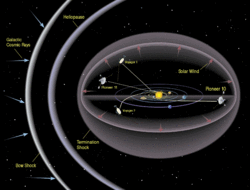Research

Thomsen's early research was on the magnetospheres of Jupiter [6] [7] [8] [9] and Saturn. [10] [11] Her research on Earth's bow shock used the ISEE-1 and ISEE-2 satellites to track the behavior of high energy particles from the magnetosphere. [12] [13] She has also studied the cavities upstream of Earth's bow shock, [14] the comet 21P/Giacobini–Zinner, [15] [16] and the physics of collisionless shocks. [17] [18] As a co-investigator of the co-investigator of Cassini Plasma Spectrometer (CAPS) program, [19] she used the Cassini–Huygens mission to research Saturn and its moons. [20] [21]
Selected publications
- Young, D. T.; Berthelier, J. J.; Blanc, M.; Burch, J. L.; Coates, A. J.; Goldstein, R.; Grande, M.; Hill, T. W.; Johnson, R. E.; Kelha, V.; Mccomas, D. J.; Sittler, E. C.; Svenes, K. R.; Szegö, K.; Tanskanen, P.; Ahola, K.; Anderson, D.; Bakshi, S.; Baragiola, R. A.; Barraclough, B. L.; Black, R. K.; Bolton, S.; Booker, T.; Bowman, R.; Casey, P.; Crary, F. J.; Delapp, D.; Dirks, G.; Eaker, N.; Funsten, H.; Furman, J. D.; Gosling, J. T.; Hannula, H.; Holmlund, C.; Huomo, H.; Illiano, J. M.; Jensen, P.; Johnson, M. A.; Linder, D. R.; Luntama, T.; Maurice, S.; Mccabe, K. P.; Mursula, K.; Narheim, B. T.; Nordholt, J. E.; Preece, A.; Rudzki, J.; Ruitberg, A.; Smith, K.; Szalai, S.; Thomsen, M. F.; Viherkanto, K.; Vilppola, J.; Vollmer, T.; Wahl, T. E.; Wüest, M.; Ylikorpi, T.; Zinsmeyer, C. (September 2004). "Cassini Plasma Spectrometer Investigation". Space Science Reviews. 114 (1–4): 1–112. Bibcode:2004SSRv..114....1Y. doi:10.1007/s11214-004-1406-4. S2CID 125352558.
- Feldman, W. C.; Anderson, R. C.; Bame, S. J.; Gary, S. P.; Gosling, J. T.; McComas, D. J.; Thomsen, M. F.; Paschmann, G.; Hoppe, M. M. (1983). "Electron velocity distributions near the Earth's bow shock". Journal of Geophysical Research: Space Physics. 88 (A1): 96–110. Bibcode:1983JGR....88...96F. doi:10.1029/JA088iA01p00096.
- Thomsen, M. F.; Reisenfeld, D. B.; Delapp, D. M.; Tokar, R. L.; Young, D. T.; Crary, F. J.; Sittler, E. C.; McGraw, M. A.; Williams, J. D. (2010). "Survey of ion plasma parameters in Saturn's magnetosphere". Journal of Geophysical Research: Space Physics. 115 (A10): n/a. Bibcode:2010JGRA..11510220T. doi:10.1029/2010JA015267.
- Thomsen, M. F. (2004). "Why Kp is such a good measure of magnetospheric convection". Space Weather. 2 (11): n/a. Bibcode:2004SpWea...211004T. doi:10.1029/2004SW000089. S2CID 118639459.